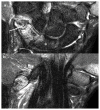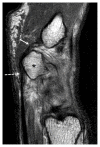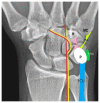An uncommon case of traumatic pisiform dislocation with triquetral fracture
- PMID: 35530418
- PMCID: PMC9063818
- DOI: 10.3941/jrcr.v16i4.4474
An uncommon case of traumatic pisiform dislocation with triquetral fracture
Abstract
The pisiform is a sesamoid bone that acts as one of the key medial stabilizers of the wrist. We present a case of a 35-year-old gentleman who presented with medial wrist pain following a fall while rollerblading. Radiographs and Magnetic resonance imaging (MRI) revealed a rare combination of an acute pisiform dislocation with associated triquetral fracture. Subsequently, he was successfully treated with excision of the pisiform. Pisiform dislocation is an uncommon injury and can easily be missed in an acute emergency presentation. Therefore, it is important to be aware of the characteristic imaging appearance to avoid a delay in diagnosis and treatment.
Keywords: Pisiform; dislocation; excision; fracture; triquetrum.
Copyright Journal of Radiology Case Reports.
Figures







Similar articles
-
Pisiform dislocation.BMJ Case Rep. 2021 Jan 6;14(1):e237482. doi: 10.1136/bcr-2020-237482. BMJ Case Rep. 2021. PMID: 33408102 Free PMC article.
-
Conservative treatment of the isolated dislocation of the pisiform bone.J Plast Surg Hand Surg. 2014 Aug;48(4):283-4. doi: 10.3109/2000656X.2013.779799. Epub 2013 Jul 8. J Plast Surg Hand Surg. 2014. PMID: 23834301
-
Posttraumatic Arthrosis and Triquetral Nonunion Associated With Pisotriquetral Subluxation in Adolescent Female Softball Players.J Hand Surg Am. 2022 Oct;47(10):1021.e1-1021.e4. doi: 10.1016/j.jhsa.2021.07.032. Epub 2021 Sep 17. J Hand Surg Am. 2022. PMID: 34538669
-
[Dislocation of the pisiform bone. A review of the literature].Handchir Mikrochir Plast Chir. 2002 May;34(3):168-72. doi: 10.1055/s-2002-33688. Handchir Mikrochir Plast Chir. 2002. PMID: 12203150 Review. German.
-
Pisiform and hamate coalition: case report and review of literature.Hand Surg. 2005 Jul;10(1):101-4. doi: 10.1142/S0218810405002486. Hand Surg. 2005. PMID: 16106510 Review.
Cited by
-
Isolated Non-displaced Pisiform Fracture: A Diagnostic Challenge in Ulnar-Sided Wrist Trauma Managed Conservatively.Cureus. 2025 Jul 9;17(7):e87637. doi: 10.7759/cureus.87637. eCollection 2025 Jul. Cureus. 2025. PMID: 40786272 Free PMC article.
References
-
- Hurni Y, Fusetti C, De Rosa V. Fracture dislocation of the pisiform bone in children: a case report and review of the literature. J Pediatr Orthop B. 2015;24(6):556–60. - PubMed
-
- Blum AG, Zabel JP, Kohlmann R, et al. Pathologic conditions of the hypothenar eminence: evaluation with multidetector CT and MR imaging. Radiographics. 2016;26(4):1021–44. - PubMed
Publication types
MeSH terms
LinkOut - more resources
Full Text Sources
Medical

